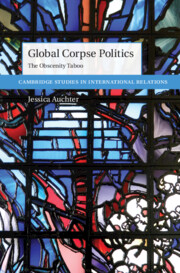Book contents
- Global Corpse Politics
- Global Corpse Politics
- Global Corpse Politics
- Copyright page
- Contents
- Acknowledgments
- 1 Visualizing Corpse Politics
- 2 HORRIFICALLY GRAPHIC
- 3 The Visual Politics of ISIS Beheadings
- 4 Dead Terrorists and Dead Dictators
- 5 Proof of Death
- 6 Displaying the Dead Body
- References
- Index
- Cambridge Studies in International Relations
3 - The Visual Politics of ISIS Beheadings
Published online by Cambridge University Press: 24 September 2021
- Global Corpse Politics
- Global Corpse Politics
- Global Corpse Politics
- Copyright page
- Contents
- Acknowledgments
- 1 Visualizing Corpse Politics
- 2 HORRIFICALLY GRAPHIC
- 3 The Visual Politics of ISIS Beheadings
- 4 Dead Terrorists and Dead Dictators
- 5 Proof of Death
- 6 Displaying the Dead Body
- References
- Index
- Cambridge Studies in International Relations
Summary
Chapter 3 examines a double paradox with regards to ISIS and fear: first, that ISIS beheadings are a spectacle, while at the same time, there exists an image ban on viewing these images, and second, that ISIS is both inherently known as a threat, yet also fundamentally unknowable. It uses the framing of the Bilderverbot, the secularized image ban of biblical origin, to examine how beheadings are represented as unrepresentable, and how this paradox enters into normalcy. The chapter tells the story of two beheadings: one of an Iraqi head and one of a Western one. The first is shown but not seen, and the latter is seen but not shown. A micro-level examination of the severed head image allows these stories to emerge. The first account, concerning the severed head of an Iraqi man working as an informant for American soldiers, allows for an examination of how beheadings are often depicted in the language of horror, or as an example of “body horror.” The second story, the story of ISIS beheadings, is one in which the severed head has become a fact of international politics and in which fear of ISIS beheadings is taken for granted.
- Type
- Chapter
- Information
- Global Corpse PoliticsThe Obscenity Taboo, pp. 62 - 89Publisher: Cambridge University PressPrint publication year: 2021

